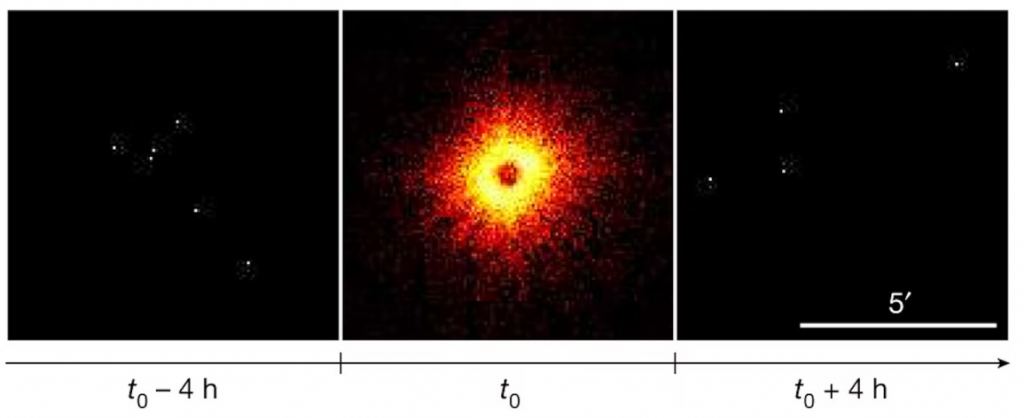On July 7, 2020, the X-ray instrument eROSITA captured an astronomical event that – until then – had only been theorized and never seen. It saw the detonation of a nova on a white dwarf star, which produced a so-called fireball explosion of X-rays.
“It was to some extent a fortunate coincidence, really,” said Ole König from Friedrich-Alexander-Universität Erlangen-Nürnberg (FAU), who led the team of scientists who have published a new paper on the discovery. “These X-ray flashes last only a few hours and are almost impossible to predict, but the observational instrument must be pointed directly at the explosion at exactly the right time.”
A white dwarf is a small, very dense star that forms when a low-mass star uses up all its fuel. Typically, white dwarfs are the size of a planet. Sometimes these dead stars flare back to life in a super-hot explosion and produce a fireball of X-ray radiation, and then it gradually returns to its original brightness. As opposed to a supernova, which is an explosion of a star where most of the material is ejected from the star, a nova does not eject much mass of the star and can occur several times in the life of a white dwarf.
“These so-called novae do happen all the time but detecting them during the very first moments when most of the X-ray emission is produced is really hard,” said Dr. Victor Doroshenko from Tübingen University, also part of the research team. “Not only the short duration of a flash is a challenge, but also the fact that the spectrum of emitted X-rays is very soft. Soft X-rays are not very energetic and easily absorbed by interstellar medium, so we cannot see very far in this band, which limits the number of observable objects, be it a nova or ordinary star. Telescopes are normally designed to be most effective in harder X-rays where absorption is less important, and that’s exactly the reason why they would miss an event like this!”
eROSITA is the primary instrument on-board the Russian-German Spectrum-Roentgen-Gamma (SRG) mission, which – like the James Webb Space Telescope – is in a halo orbit around the second Lagrange point. It has been in space since 2019 is conducting the first all-sky survey in the medium energy X-ray range (up to 10 keV).
The existence of a ‘fireball’ phase immediately after the runaway fusion nova event has been theorized for 30 years. Scientists predicted it should be observable as a short, bright and soft X-ray flash before the nova becomes visible in the optical range. The trick to seeing it, as König said, is to have your telescope pointed at the right place at the right time.
In their paper, published in Nature, the team said that no X-ray source was detected 4?hours on either side of when the visible flash was detected, which constrains the duration of the flash to shorter than 8?hours.

The nova happened on YZ Reticuli, also known as Nova Reticuli 2020, which was a naked eye nova in the constellation Reticulum discovered on July 15, 2020. Previously it was known as a VY Sculptoris type object with the designation MGAB-V207. Nova Reticuli 2020 was spotted by veteran comet hunter Robert McNaught from Coonabarabran, Australia. It was visible in the southern hemisphere for several days, and just barely visible to the naked eye.
“The physical origin of X-ray emission coming from white dwarf atmospheres is relatively well understood, and we can model their spectra from first principles and in exquisite detail,” said Dr. Valery Suleimanov, also from Tübingen University. “Comparison of models with observations allows then to learn basic properties of these objects such as weight, size, or chemical composition.”
“The problem in this particular case,” added Doroshenko, “was, however, that, after 30 years with no photons we suddenly had too many, which distorted the spectral response of eROSITA, which was designed to detect millions of very faint objects rather than one but very bright.”
Since these novae run out of fuel very quickly, they cool rapidly and the X-ray radiation be-comes weaker until it eventually becomes visible light. Since these novae are only visible after the X-ray flash, it is very difficult to predict such outbreaks and it is mainly down to chance when they hit the X-ray detectors. The visible light reached Earth 12 hours after the eROSITA detection, when it was first observed by McNaught.
“A seemingly bright star then appeared, which was actually the visible light from the explosion, and so bright that it could be seen on the night sky by the bare eye,” said König. “We were really lucky.”
Sources:
Paper in Nature
Press release from Tübingen University
The post Astronomers Finally Catch a Nova Detonating on a White Dwarf as it's Happening appeared first on Universe Today.
No comments:
Post a Comment